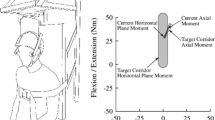Abstract
Background
Computer models and human surrogates used to study the forces and motion of the human neck under various loading conditions are based solely on adult data. Pediatric computer models and dummy surrogates used to improve the safety of children could be improved with the inclusion of previously unavailable pediatric muscle data.
Methods
Measurements of neck circumference and neck muscle cross-sectional area (CSA) were taken from ten 50th percentile adult male and ten 10-year old male volunteer subjects. Muscle cross-sectional areas were calculated from magnetic resonance images of axial cross-sections of the neck.
Results
Neck muscle cross-sectional area was calculated for six muscles/muscle groups. A power-law regression analysis was used to describe the relationship between neck circumference and neck muscle cross-sectional area.
Conclusions
The cross-sectional area and the power-law functions determined by the data in this study provide a means of calculating muscle cross-sectional area for young children, where such data are currently unavailable. This will provide an opportunity to develop more representative pediatric neck models.



Similar content being viewed by others
References
Borst J, Forbes PA, Hapee R, Veeger DJ (2011) Muscle parameters for musculoskeletal modelling of the human neck. Clin Biomech. doi:10.1016/j.clinbiomech.2010.11.019
Brown RL, Brunn MA, Garcia VF (2001) Cervical Spine injuries in children: a review of 103 patients treated consecutively at a level 1 pediatric trauma center. J Pediatr Surg 36(8):1107–1114
Cagnie B, Barbe T, Vandemaele P, Achten E, Cambier D, Danneels L (2009) MRI analysis of muscle/fat index of the superficial and deep neck muscles in an asymptomatic cohort. Eur Spine J 18(5):704–709
Cirak B, Ziegfeld S, Knight VM, Chang D, Avellino AM, Paidas CN (2004)Spinal injuries in children. J Pediatr Surg 39(4):607–612
Choi H, Vanderby R (2000) Muscle forces and spinal loads at C4/5 level during isometric voluntary efforts. Med Sci Sports Exerc 32:830–838
De Loose V, Van den Oord M, Keser I, Burnotte F, Van Tiggelen D, Dumary A, Cagnie B, Witvrouw E, Danneels L (2009) MRI study of the morphometry of the cervical musculature in F-16 pilots. Aviat Space Environ Med 80:727–731
Givens TG, Polley KA, Smith CF, Hardin WD Jr (1996) Pediatric cervical spine injury: a three year experience. J Trauma Inj Infect Crit Care 41(2):310–314
Knapik JJ, Staab JS, Harman EA (1996) Validity of an anthropometric estimate of thigh muscle cross-sectional area. Med Sci Sports Exerc 28(12):1523–1530
Kokoschka ER, Keller MS, Rallo MC, Weber TR (2001) Characteristics of pediatric cervical spine injuries. J Pediatr Surg 36(1):100–105
Kumerasan S, Yoganandan N, Pintar F (2001) Pediatric neck injury scale factors and tolerance. Biomed Sci Instrum 37:435–440
McCall T, Fassett D, Brockmeyer D (2006) Cervical spine trauma in children: a review. Neurosurg Focus 20(2):E5
McDowell MA, Fryar CD, Hirsch R, Ogden CL (2005) Anthropometric reference data for children and adults: US population, 1999–2002. National Heath and Statistics Report, US Department of Health and Human Services, No. 361
Miller HJ (2003) Verification of the child crash test dummy neck response using magnetic resonance imaging and physiologic muscle stress. PhD Dissertation, Wayne State University
Moroney SP, Schultz AB, Miller JA (1988) Analysis and measurement of neck loads. J Orthop Res 6(5):713–720
Okada E, Matsumoto M, Ichihara D, Chiba K, Toyama Y, Fujiwara H, Momoshima S, Nishiwaki Y, Takahata T (2011) Cross-sectional area of posterior extensor muscles of the cervical spine in asymptomatic subjects: a 10-year longitudinal magnetic resonance imaging study. Eur Spine J 20(9):1567–1573
Oksanen A, Erkintalo M, Metsahonkala L, Anttila P, Laimi K, Hiekkanen H, Salminen J, Aromaa M, Sillanpää M (2008) Neck muscle cross-sectional area in adolescents with and without headache—MRI study. Eur J Pain 12:952–959
Stemper BD, Baidsen JL, Yognanadan N, Pintar FA, Pakoff GR, Shender BS (2010) Determination of normative neck muscle morphometry using upright MRI with comparison to supine data. Aviat Space Environ Med 81:878–882
Van Ee CA, Nightingale RW, Camacho DLA, Chancey VC, Knaub KE, Sun EA, Myers BS (2000) Tensile properties of the human muscular and ligamentous cervical spine. In: Proceedings from the 44th Stapp Car Crash Conference, 2000-01-SC07
Vasavada AN, Li S, Delp SL (1998) Influence of muscle morphometry and moment arms on the moment-generating capacity of human neck muscles. Spine 23:412–422
Zuckerbraun BS, Morrison K, Gaines B, Ford HR, Hackam DJ (2004) Effects of age on cervical spine injuries in children after motor vehicle collisions: effectiveness of restraint devices. J Pediatr Surg 39(3):483–486
Acknowledgments
This study was funded in part by a Wayne State University Rumble Scholarship, a Ford Fellowship Scholarship and through support from the Detroit Medical Center and the Wayne State University BioEngineering Center.
Conflict of interest
None.
Author information
Authors and Affiliations
Corresponding author
Rights and permissions
About this article
Cite this article
Dawson, R.M., Latif, Z., Haacke, E.M. et al. Magnetic resonance imaging-based relationships between neck muscle cross-sectional area and neck circumference for adults and children. Eur Spine J 22, 446–452 (2013). https://doi.org/10.1007/s00586-012-2482-x
Received:
Revised:
Accepted:
Published:
Issue Date:
DOI: https://doi.org/10.1007/s00586-012-2482-x




